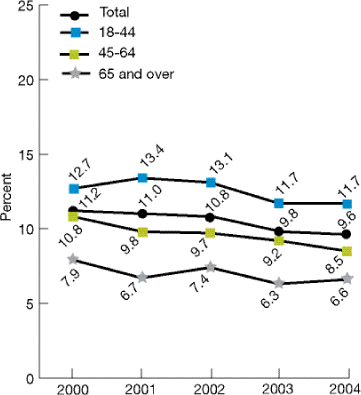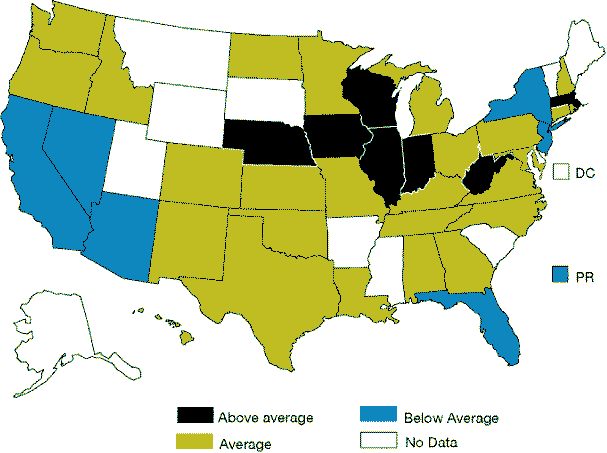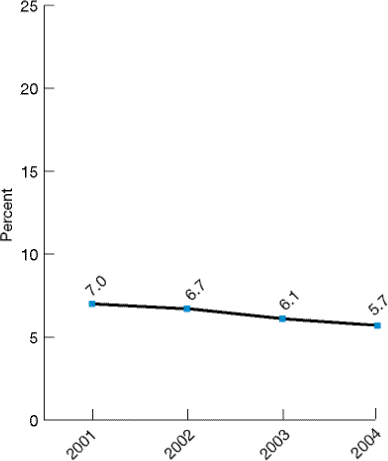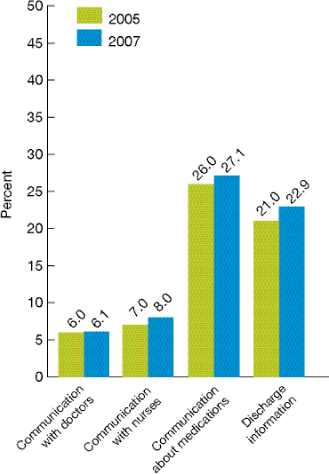Chapter 5. Patient Centeredness
Patient centeredness is defined as: "[H]ealth care that establishes a partnership among practitioners, patients, and their families (when appropriate) to ensure that decisions respect patients' wants, needs, and preferences and that patients have the education and support they need to make decisions and participate in their own care."1 An important dimension of quality, patient centeredness "encompasses qualities of compassion, empathy, and responsiveness to the needs, values, and expressed preferences of the individual patient."2
Importance and Measures
Morbidity and Mortality
- Patient centered approaches to care that rely on building a provider-patient relationship, improving communication techniques, fostering a positive atmosphere, and encouraging patients to actively participate in patient-provider interactions have been shown to improve the health status of patients.3, 4
- A patient centered approach has been shown to lessen the symptom burden on patients.5
- Patient centered care encourages patients to comply with and adhere to treatment regimens.6
- Patient centered care can reduce the chance of misdiagnosis due to poor communication.7
Cost
- Patient centeredness has been shown to reduce both under use and overuse of medical services.8
- Patient centeredness can reduce the strain on system resources or save money by reducing the number of diagnostic tests and referrals.5
- Although some studies have shown that being patient centered reduces costs and use of health service resources, others have shown that patient centeredness increases costs to providers, especially in the short run.9
Measures
The NHQR tracks four measures of the patient experience of care. The core report measure is a composite of these measures—patient assessments of how often their provider listened carefully to them, explained things clearly, respected what they had to say, and spent enough time with them.
In addition, as in the 2006 NHQR, the 2007 NHQR presents four composite supplemental measures from the Hospital Consumer Assessment of Healthcare Providers and Systems (H-CAHPS), the hospital version of CAHPS®, that focus on the quality of communication that patients experience during their hospital stay. This is important not only because effective patient-provider communication can help ensure that medical decisions are consistent with the patient's needs and preferences, but also because patients can help providers avoid problems with medications and problems that may arise after they are discharged.
Return to Contents
Findings
Patient Experience of Care—Adults
Optimal health care requires good communication between patients and providers, yet barriers to patient provider communication are common. To provide all patients with the best possible care, providers must be able to understand patients' diverse health care needs and preferences and communicate clearly with patients about their care.
Figure 5.1. Ambulatory patients age 18 and over who reported poor communication with health providers,* by age group, 2000-2004

* Average percentage of adults who had a doctor's office or clinic visit in the last 12 months and reported poor communication with health providers (i.e., that their health providers sometimes or never listened carefully, explained things clearly, showed respect for what they had to say, and spent enough time with them).
Source: Agency for Healthcare Research and Quality, Medical Expenditure Panel Survey, 2000-2004.
Denominator: Civilian noninstitutionalized population age 18 and over who visited a doctor's office or clinic to get health care in the last 12 months.
- In 2004, 9.6% of adults who had a doctor's office or clinic visit in the last 12 months reported poor communication (Figure 5.1).
- Between 2000 and 2004, the average percentage of adults with a doctor's office or clinic visit who reported poor communication decreased for the total population from 11.2% to 9.6%. Most of this improvement occurred between 2002 and 2003.
- Improvements were also seen from 2000 to 2004 for adults ages 45-64. There was no significant change in the percentages for adults ages 18-44 or 65 and over.
- In all five data years, the average percentage of adults with doctor's office or clinic visits who reported poor communication was lowest among adults 65 and over.
Figure 5.2. State variation: Ambulatory patients who reported good communication with health providers,* 2005

* Average percentage of adults who had a doctor's office or clinic visit in the last 12 months and reported good communication with health providers (i.e., that their health providers always listened carefully, explained things clearly, showed respect for what they had to say, and spent enough time with them).
Source: Agency for Healthcare Research and Quality, National CAHPS® Benchmarking Database.
Key: Higher rate = rate is significantly above the all States average in 2006. Lower rate = rate is significantly below the all States average in 2006.
Denominator: Adults with Medicare fee-for-service benefits who visited a doctor's office or clinic in the past 12 months.
Note: "All States average" is the average of all responding States (40 in this case, including Puerto Rico), which is a separate figure from the national average.
- In 2005, individual State scores for this composite measurei of communication with health providers ranged from a low (i.e., worse communication) of 60.4% to a high of 74.8%.
- In 2005, seven Statesii were above (i.e., better communication) the all States average of 70.2% for this composite measure of communication with health providers (Figure 5.2).
- Seven Statesiii were below (i.e., worse communication) the all States average for this measure in 2005.
iNote that respondents were asked to choose between "sometimes," "never," "usually," or "always." In contrast to Figure 5.1, the map shown in Figure 5.2 displays results for respondents answering "always."
ii The States were Illinois, Indiana, Iowa, Massachusetts, Nebraska, West Virginia, and Wisconsin.
iii The States were Arizona, California, Florida, Nevada, New Jersey, New York, and Puerto Rico.
Patient Experience of Care—Children
Communication in children's health care can pose a particular challenge as children are often less able to express their health care needs and preferences, and a third party (i.e., a parent or guardian) is involved in communication and decision-making. Optimal communication in children's health care can therefore have a significant impact on receipt of high quality care and subsequent health status.
Figure 5.3. Children under age 18 with ambulatory visits whose parents reported poor communication with health providers,* 2001-2004

* Average percentage of children who had a doctor's office or clinic visit in the last 12 months and were reported to have had poor communication with health providers (i.e., that their health providers sometimes or never listened carefully, explained things clearly, showed respect for what they had to say, and spent enough time with them).
Source: Agency for Healthcare Research and Quality, Medical Expenditure Panel Survey, 2001-2004.
Denominator: Civilian noninstitutionalized population under 18 years who visited a doctor's office or clinic to get heath care in the last 12 months.
- In 2004, 5.7% of parents of children who had a doctor's office or clinic visit in the last 12 months reported poor communication with health providers. This rate, although low overall, did not improve significantly over the 2001-2004 time period (Figure 5.3).
Focus on Patient Centeredness in Hospitals
To capture information about patient perceptions of care when they are hospitalized, the Centers for Medicare & Medicaid Services and AHRQ partnered to develop a standardized instrument, the CAHPS® Hospital Survey (H-CAHPS). In 2005, 254 U.S. hospitals volunteered to use this survey. In total, completed surveys were received from 84,779 respondents with an average response rate of 44%. Although it is not nationally representative, the sample of hospitals and respondents is comparable with the national distribution of hospitals registered with the American Hospital Association.10
The 2007 NHQR presents four composite measures from H-CAHPS: "Communication with doctors" summarizes responses to three questions examining how often patients were treated with courtesy and respect by their doctors, how often doctors listened carefully, and how often doctors explained things in a way that patients were able to understand. "Communication with nurses" combines the same three questions in relation to nurses. "Communication about new medications" combines responses from two questions: how often hospital staff told patients the purpose of a new medicine and how often hospital staff described possible side effects in a way that patients could understand. "Discharge information" combines responses from two questions: whether hospital staff spoke with patients about whether they would have the help they needed after leaving the hospital and whether patients reported receiving written information on symptoms or health problems of which they should be aware after discharge.
Figure 5.4. Adult hospital patients who reported poor communication* with doctors, with nurses, about new medications, and about discharge information, 2005 and 2007

* Responded "sometimes," "never," or "no" to any question in the set of survey questions for each measure. Communication with doctors/nurses:
"During this hospital stay, how often did doctors/nurses treat you with courtesy and respect?", "During this hospital stay, how often did doctors/nurses listen carefully to you?", and "During this hospital stay, how often did doctors/nurses explain things in a way you could understand?"
Communication about new medications:
"Before giving you any new medicine, how often did hospital staff tell you what the medicine was for?" and "Before giving you any new medicine, how often did hospital staff describe possible side effects in a way you could understand?"
Discharge information:
"During this hospital stay, did doctors, nurses or other hospital staff talk with you about whether you would have the help you needed when you left the hospital?" and "During this hospital stay, did you get information in writing about what symptoms or health problems to look out for after you left the hospital?"
Source: Agency for Healthcare Research and Quality, Consumer Assessment of Healthcare Providers and Systems (CAHPS®) Hospital Survey, 2005 and 2007.
Denominator: Hospital patients age 18 years and over
Notes: Data are not necessarily nationally representative. The hospitals providing data in these two periods are not the same, and the data are not adjusted for mode and patient mix, so comparisons over time must be interpreted with caution.
- Communication between hospital patients and doctors and nurses and about new medications and discharge information did not improve and, for some age groups, worsened between 2005 and 2007. During this period, the percentage of hospital patients who reported poor communication with their doctors during their stay remained relatively unchanged (Figure 5.4).
- Significantly higher (worse) percentages of hospital patients reported poor communication with nurses and about new medications and discharge information in 2007 compared with 2005 (8.0% versus 7.0%, 27.1% versus 26.0%, and 22.9% versus 21.0%, respectively).
Return to Contents
References
1. Institute of Medicine. Envisioning the national health care quality report. Washington, DC: National Academy Press; 2001.
2. Institute of Medicine, Committee on Quality of Health Care in America. Crossing the quality chasm: a new health system for the 21st century. Washington, DC: National Academy Press; 2001.
3. Stewart M, Brown JB, Donner A, et al. The impact of patient-centered care on outcomes. J Fam Pract. 2000 Sep;49(9):796-804.
4. Anderson EB. Patient-centeredness: a new approach. Nephrol News Issues. 2002 Nov; 16(12): 80-82.
5. Little P, Everitt H, Williamson I, et al. Observational study of effect of patient centeredness and positive approach on outcomes of general practice consultations. BMJ. 2001 Oct 20;323(7318):908-11.
6. Beck R, Daughtridge R, Sloane PD. Physician-patient communication in the primary care office: a systematic review. J Am Board Fam Pract. 2002 Jan-Feb; 15(1): 25-38.
7. DiMatteo M. The role of the physician in the emerging health care environment. West J Med. 1998 May; 168(5): 328-33.
8. Berry L, Seiders K, Wilder SS. Innovations in access to care: a patient-centered approach. Ann Intern Med. 2003 Oct 7; 139(7): 568-74.
9. Bechel D, Myers WA, Smith DG. Does patient-centered care pay off? Jt Comm J Qual Improv. 2000;26(7):400-409.
10. Agency for Healthcare Research and Quality. CAHPS® hospital survey chartbook: what patients say about their experiences with hospital care. Report of summary data from hospital test sites. Prepublication copy; March 2006. Available at: https://www.cahps.ahrq.gov/content/NCBD/PDF/HCAHPS_Chartbook_2006.pdf [PDF Help]. Accessed October 30, 2007.

